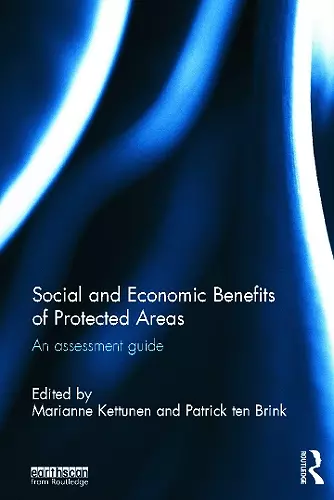Social and Economic Benefits of Protected Areas
An Assessment Guide
Patrick Ten Brink editor Marianne Kettunen editor
Format:Hardback
Publisher:Taylor & Francis Ltd
Published:28th Aug '13
Currently unavailable, and unfortunately no date known when it will be back
This hardback is available in another edition too:
- Paperback£56.99(9780415632843)

Protected areas (PAs) contain biodiversity and ecosystems of high conservation value. In addition, these areas provide a range of benefits, both direct and indirect, to our societies and economies, i.e. so called ecosystem services. These services include, for example, an ecosystem's ability to regulate floods and climate, purify water, secure the pollination of crops, and create opportunities for recreation, culture and tourism.
This book offers a comprehensive introduction to the socio-economic benefits of PAs and PA networks and provides step-by-step practical guidance on identifying, assessing and valuing the various ecosystem services and related benefits provided by PAs. It also aims to improve the communication of PA benefits to different stakeholders and the general public. It is shown that identifying and valuing the socio-economic benefits of PAs can be beneficial for several reasons. Demonstrating socio-economic importance of a protected site can significantly increase political and stakeholder support for the site and resolve conflicts between different interest groups. This can lead to positive changes in policies and decision-making. Insights on PA benefits are also needed to identify a combination of actions and land use practices that best support the sustainable and equitable utilisation of these benefits, while retaining a site’s conservation goals. Finally, demonstrating different benefits can help to discover alternative and sustainable sources for financing the management of PAs.
"This book is [therefore] extremely welcome, coming at the moment when interest in assessment is higher than at any time before. The team of authors, led by Marianne Kettunen and Patrick ten Brink from the Institute for European Environmental Policy (IEEP), has assembled an impressive global evidence base and practical advice, drawing on years of experience. We urge everyone involved in protected areas conservation to benefit from its guidance and help to promote protected areas as natural solutions to many of the world’s sustainability challenges." – From the Foreword by Braulio F. de Souza Dias, Executive Secretary, Secretariat of the Convention on Biological Diversity (CBD) and Ernesto Enkerlin-Hoeflich, Chair of the World Commission on Protected Areas (WCPA), International Union for Conservation of Nature (IUCN)
"This book presents a timely and practical guide to assessing and communicating the multiple values of protected areas, whether inland or coastal wetlands, drylands, grasslands, forests or marine areas in the open oceans. Essential reading for all wishing to ensure that nature is more fully taken into account in decision making, including all those responsible for managing and maintaining the health of the over 2000 Ramsar Sites worldwide." – Professor Nick Davidson, Deputy Secretary General, Ramsar Convention Secretariat
"This guidebook is incredibly comprehensive and useful for all practitioners attempting to present socio-economic values of PAs. It will undoubtedly lead to a whole host of new and strong PA valuation studies important for advancing the conservation agenda." –Andrew Bovarnick, Lead Natural Resource Economist, UNDP
"The Guide provides a very welcome contribution to filling the gap that currently exists in the availability of practical tools and approaches for documenting, analysing and communicating the social and economic benefits of Protected Areas. Economists, conservation planners and policy-makers will all gain from the insights and techniques that are presented. The book is a core resource which will undoubtedly prove useful in strengthening protected area planning and management." – Lucy Emerton, Director of Economics & Finance, Environment Management Group
"A timely, practical and inspiring guidebook that helps us to value the multiple benefits of protected areas and to communicate them better to local people and decision-makers. A must-read for all protected area managers!" – Sanna-Kaisa Juvonen, Senior Advisor for International Affairs, Metsähallitus Natural Heritage Services, Finland
"This book is an excellent, practice-oriented overview of current methodological approaches and challenges to assess the ecosystem services provided by protected areas. It gives clear indication and guidance how to better understand the potentials and shortcomings of assessing and valuing nature and how these values can be taken up by and communicated to the decision making processes." – Alberto Arroyo Schnell, Senior Policy Advisor on Biodiversity, Andreas Baumüller, Head of Natural Resources and Land Use and Peter Torkler, EU Policy, WWF
"Not all commons are protected areas, but the management of commons also benefit from a better understanding of their socio-economic values. This book will help decision makers in selecting the most appropriate policies and practices of land use."--International Journal of the Commons, Vol 8, No 1 (2014)
"This book has synthesized some key aspects of socio-economic benefit assessments of protected areas. Eight contributors including two co-editors have discussed details on this subject, widely deliberated across various biodiversity conventions during the last two decades."
--Journal for Nature Conservation, 25 December 2013
"The primary target audience for this guide is those involved in the designation and management of protected areas who wish to explore the socio-economic arguments for conservation. It is effectively both a synthesis of evidence from a wide range of contexts of the benefits of protected areas, as well as a step-by-step practical guide on how to identify, assess and communicate those benefits, focusing on socio-economic values." – Helen Schneider, Fauna & Flora International, Cambridge, UK
ISBN: 9780415632836
Dimensions: unknown
Weight: 657g
368 pages